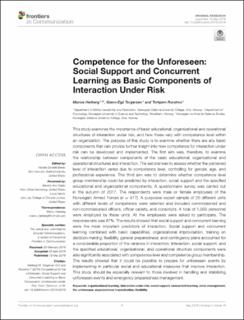| dc.contributor.author | Herberg, Marius | |
| dc.contributor.author | Torgersen, Glenn-Egil | |
| dc.contributor.author | Rundmo, Torbjørn | |
| dc.date.accessioned | 2021-07-05T08:07:56Z | |
| dc.date.available | 2021-07-05T08:07:56Z | |
| dc.date.created | 2021-07-02T16:21:27Z | |
| dc.date.issued | 2019 | |
| dc.identifier.citation | Frontiers in Communication. 2019, 4 (19), 1-19. | en_US |
| dc.identifier.issn | 2297-900X | |
| dc.identifier.uri | https://hdl.handle.net/11250/2763292 | |
| dc.description.abstract | This study examines the importance of basic educational, organizational and operational structures of interaction under risk, and how these vary with competence level within an organization. The purpose of this study is to examine whether there are any basic components that can provide further insight into how competence for interaction under risk can be developed and implemented. The first aim was, therefore, to examine the relationship between components of the basic educational, organizational and operational structures and interaction. The second was to assess whether the perceived level of interaction varies due to competence level, controlling for gender, age, and professional experience. The third aim was to determine whether competence level group membership could be predicted by interaction, social support and the specified educational and organizational components. A questionnaire survey was carried out in the autumn of 2017. The respondents were male or female employees of the Norwegian Armed Forces (n = 917). A purposive expert sample of 20 different units with different levels of competence were selected and included commissioned and non-commissioned officers, officer cadets, and conscripts. A total of 1,050 personnel were employed by these units. All the employees were asked to participate. The response rate was 87%. The results showed that social support and concurrent learning were the most important predictors of interaction. Social support and concurrent learning combined with basic capabilities, organizational improvisation, training on decision-making, flexibility, general preparedness, and contingency plans accounted for a considerable proportion of the variance in interaction. Interaction, social support, and the specified educational, organizational, and operational structure components were also significantly associated with competence level and competence group membership. The results showed that it could be possible to prepare for unforeseen events by implementing in particular social and educational measures that improve interaction. This study should be especially relevant to those involved in handling and stabilizing unforeseen events and emergency preparedness management. | en_US |
| dc.language.iso | eng | en_US |
| dc.publisher | Frontiers Media | en_US |
| dc.rights | Navngivelse 4.0 Internasjonal | * |
| dc.rights.uri | http://creativecommons.org/licenses/by/4.0/deed.no | * |
| dc.title | Competence for the Unforeseen: Social Support and Concurrent Learning as Basic Components of Interaction Under Risk | en_US |
| dc.type | Peer reviewed | en_US |
| dc.type | Journal article | en_US |
| dc.description.version | publishedVersion | en_US |
| dc.source.pagenumber | 1-19 | en_US |
| dc.source.volume | 4 | en_US |
| dc.source.journal | Frontiers in Communication | en_US |
| dc.source.issue | 19 | en_US |
| dc.identifier.doi | https://doi.org/10.3389/fcomm.2019.00019 | |
| dc.identifier.cristin | 1920147 | |
| dc.description.localcode | Copyright © 2019 Herberg, Torgersen and Rundmo. This is an open-access article distributed under the terms of the Creative Commons Attribution License (CC BY). The use, distribution or reproduction in other forums is permitted, provided the original author(s) and the copyright owner(s) are credited and that the original publication in this journal is cited, in accordance with accepted academic practice. No use, distribution or reproduction is permitted which does not comply with these terms. | en_US |
| cristin.ispublished | true | |
| cristin.fulltext | original | |
| cristin.qualitycode | 1 | |

